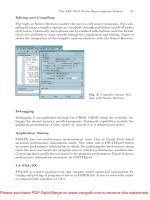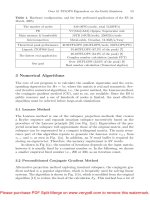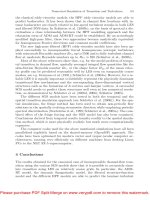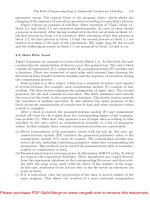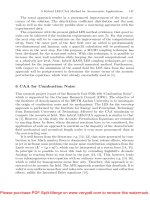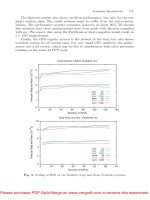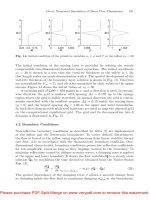High performance computing in finance problems, methods, and solutions
Bạn đang xem bản rút gọn của tài liệu. Xem và tải ngay bản đầy đủ của tài liệu tại đây (20.9 MB, 637 trang )
High-Performance
Computing in Finance
Problems, Methods,
and Solutions
High-Performance
Computing in Finance
Problems, Methods,
and Solutions
Edited by
M. A. H. Dempster
Juho Kanniainen
John Keane
Erik Vynckier
MATLAB R is a trademark of The MathWorks, Inc. and is used with permission. The MathWorks
does not warrant the accuracy of the text or exercises in this book. This book’s use or discussion
of MATLAB R software or related products does not constitute endorsement or sponsorship by The
MathWorks of a particular pedagogical approach or particular use of the MATLAB R software.
CRC Press
Taylor & Francis Group
6000 Broken Sound Parkway NW, Suite 300
Boca Raton, FL 33487-2742
c 2018 by Taylor & Francis Group, LLC
CRC Press is an imprint of Taylor & Francis Group, an Informa business
No claim to original U.S. Government works
Printed on acid-free paper
International Standard Book Number-13: 978-1-4822-9966-3 (Hardback)
This book contains information obtained from authentic and highly regarded sources. Reasonable
efforts have been made to publish reliable data and information, but the author and publisher cannot
assume responsibility for the validity of all materials or the consequences of their use. The authors and
publishers have attempted to trace the copyright holders of all material reproduced in this publication
and apologize to copyright holders if permission to publish in this form has not been obtained. If any
copyright material has not been acknowledged please write and let us know so we may rectify in any
future reprint.
Except as permitted under U.S. Copyright Law, no part of this book may be reprinted, reproduced,
transmitted, or utilized in any form by any electronic, mechanical, or other means, now known or
hereafter invented, including photocopying, microfilming, and recording, or in any information storage or retrieval system, without written permission from the publishers.
For permission to photocopy or use material electronically from this work, please access
www.copyright.com ( or contact the Copyright Clearance Center, Inc.
(CCC), 222 Rosewood Drive, Danvers, MA 01923, 978-750-8400. CCC is a not-for-profit organization
that provides licenses and registration for a variety of users. For organizations that have been granted
a photocopy license by the CCC, a separate system of payment has been arranged.
Trademark Notice: Product or corporate names may be trademarks or registered trademarks, and
are used only for identification and explanation without intent to infringe.
Library of Congress Cataloging-in-Publication Data
Names: Dempster, M. A. H. (Michael Alan Howarth), 1938- editor. | Kanniainen,
Juho editor. | Keane, John. editor. | Vynckier, Erik. editor.
Title: High-performance computing in finance : problems, methods, and
solutions / [edited by] M.A.H. Dempster [and three others].
Description: Boca Raton, FL : CRC Press, 2018.
Identifiers: LCCN 2017052035| ISBN 9781482299663 (hardback) | ISBN
9781315372006 (ebook)
Subjects: LCSH: Finance--Mathematical models. | Finance--Data processing.
Classification: LCC HG106 .H544 2018 | DDC 332.01/5118--dc23
LC record available at />Visit the Taylor & Francis Web site at
and the CRC Press Web site at
Contents
Editors
xi
Contributors
xiii
Introduction
xvii
I Computationally Expensive Problems in the
Financial Industry
1 Computationally Expensive Problems in Investment
Banking
Jonathan Rosen, Christian Kahl, Russell Goyder, and Mark Gibbs
2 Using Market Sentiment to Enhance Second-Order
Stochastic Dominance Trading Models
Gautam Mitra, Christina Erlwein-Sayer, Cristiano Arbex Valle,
and Xiang Yu
3 The Alpha Engine: Designing an Automated Trading
Algorithm
Anton Golub, James B. Glattfelder, and Richard B. Olsen
4 Portfolio Liquidation and Ambiguity Aversion
´
Alvaro
Cartea, Ryan Donnelly, and Sebastian Jaimungal
5 Challenges in Scenario Generation: Modeling Market
and Non-Market Risks in Insurance
Douglas McLean
II Numerical Methods in Financial
High-Performance Computing (HPC)
6 Finite Difference Methods for Medium- and
High-Dimensional Derivative Pricing PDEs
Christoph Reisinger and Rasmus Wissmann
1
3
25
49
77
115
173
175
vii
viii
Contents
7 Multilevel Monte Carlo Methods for Applications
in Finance
Michael B. Giles and Lukasz Szpruch
197
8 Fourier and Wavelet Option Pricing Methods
Stefanus C. Maree, Luis Ortiz-Gracia, and Cornelis W. Oosterlee
249
9 A Practical Robust Long-Term Yield Curve Model
M. A. H. Dempster, Elena A. Medova, Igor Osmolovskiy, and
Philipp Ustinov
273
10 Algorithmic Differentiation
Uwe Naumann, Jonathan H¨
user, Jens Deussen,
and Jacques du Toit
315
11 Case Studies of Real-Time Risk Management
via Adjoint Algorithmic Differentiation (AAD)
Luca Capriotti and Jacky Lee
339
12 Tackling Reinsurance Contract Optimization
by Means of Evolutionary Algorithms and HPC
Omar Andres Carmona Cortes and Andrew Rau-Chaplin
371
13 Evaluating Blockchain Implementation of Clearing
and Settlement at the IATA Clearing House
Sergey Ivliev, Yulia Mizgireva, and Juan Ivan Martin
391
III HPC Systems: Hardware, Software, and
Data with Financial Applications
411
14 Supercomputers
Peter Schober
413
15 Multiscale Dataflow Computing in Finance
Oskar Mencer, Brian Boucher, Gary Robinson, Jon Gregory,
and Georgi Gaydadjiev
441
16 Manycore Parallel Computation
John Ashley and Mark Joshi
471
17 Practitioner’s Guide on the Use of Cloud Computing
in Finance
Binghuan Lin, Rainer Wehkamp, and Juho Kanniainen
509
Contents
18 Blockchains and Distributed Ledgers in Retrospective
and Perspective
Alexander Lipton
ix
537
19 Optimal Feature Selection Using a Quantum Annealer
Andrew Milne, Mark Rounds, and Peter Goddard
561
Index
589
Editors
Michael Dempster is Professor Emeritus, Centre for Financial Research,
University of Cambridge. He has held research and teaching appointments
at leading universities globally and is founding editor-in-chief of Quantitative
Finance. His numerous papers and books have won several awards, and he
is Honorary Fellow of the IFoA, Member of the Academia dei Lincei, and
managing director of Cambridge Systems Associates.
Juho Kanniainen is Professor of Financial Engineering at Tampere University of Technology, Finland. He has served as coordinator of two international EU-programs: HPC in Finance (www.hpcfinance.eu) and Big Data
in Finance (www.bigdatafinance.eu). His research is broadly in quantitative
finance, focusing on computationally expensive problems and data-driven
approaches.
John Keane is Professor of Data Engineering in the School of Computer
Science at the University of Manchester, UK. As part of the UK government’s
Foresight Project, The Future of Computer Trading in Financial Markets,
he co-authored a commissioned economic impact assessment review. He has
been involved in both the EU HPC in Finance and Big Data in Finance
programs. His wider research interests are data and decision analytics and
related performance aspects.
Erik Vynckier is board member of Foresters Friendly Society, partner of
InsurTech Venture Partners, and chief investment officer of Eli Global, following a career in banking, insurance, asset management, and petrochemical
industry. He co-founded EU initiatives on high performance computing and
big data in finance. Erik graduated as MBA at London Business School and
as chemical engineer at Universiteit Gent.
xi
Contributors
John Ashley
NVIDIA
Santa Clara, California
Brian Boucher
Luca Capriotti
Quantitative Strategies
Investment Banking Division
and
Department of Mathematics
University College London
London, United Kingdom
´
Alvaro
Cartea
Mathematical Institute
Oxford-Man Institute of
Quantitative Finance
University of Oxford
Oxford, United Kingdom
Omar Andres Carmona Cortes
Computation Department
Instituto Federal do Maranh˜
ao
S˜
ao Luis, Brazil
M. A. H. Dempster
Centre for Financial Research
University of Cambridge
and
Cambridge Systems Associates
Cambridge, United Kingdom
Jens Deussen
Department of Computer Science
RWTH Aachen University
Germany
Ryan Donnelly
Swiss Finance Institute
´
Ecole
Polytechnique F´ed´erale de
Lausanne
Switzerland
Jacques du Toit
The Numerical Algorithms Group
Ltd.
United Kingdom
Christina Erlwein-Sayer
OptiRisk Systems
Georgi Gaydadjiev
Mark Gibbs
Quantitative Research
FINCAD
Michael B. Giles
Mathematical Institute
University of Oxford
Oxford, United Kingdom
James B. Glattfelder
Department of Banking and Finance
University of Zurich
Zurich, Switzerland
Peter Goddard
1QBit
Vancouver, Canada
xiii
xiv
Contributors
Anton Golub
Lykke Corporation
Zug, Switzerland
Russell Goyder
Quantitative Research
FINCAD
Jon Gregory
Jonathan H¨
user
Department of Computer Science
RWTH Aachen University
Germany
Sergey Ivliev
Lykke Corporation
Switzerland
and
Laboratory of Cryptoeconomics and
Blockchain Systems
Perm State University
Russia
Sebastian Jaimungal
Department of Statistical Sciences
University of Toronto
Canada
Mark Joshi
Department of Economics
University of Melbourne
Melbourne, Australia
Christian Kahl
Quantitative Research
FINCAD
Juho Kanniainen
Tampere University of Technology
Tampere, Finland
Jacky Lee
Quantitative Strategies
Investment Banking Division
New York
Binghuan Lin
Tampere University of Technology
Tampere, Finland
Alexander Lipton
Stronghold Labs
Chicago, Illinois
and
MIT Connection Science and
Engineering
Cambridge, Massachusetts
Stefanus C. Maree
Centrum Wiskunde & Informatica
Amsterdam, The Netherlands
Juan Ivan Martin
International Air Transport
Association
Douglas McLean
Moody’s Analytics
Edinburgh, Scotland,
United Kingdom
Elena A. Medova
Centre for Financial Research
University of Cambridge
and
Cambridge Systems Associates
Cambridge, United Kingdom
Oskar Mencer
Andrew Milne
1QBit
Vancouver, Canada
Gautam Mitra
OptiRisk Systems and Department
of Computer Science
UCL, London, United Kingdom
Contributors
Yulia Mizgireva
Lykke Corporation
Switzerland
and
Laboratory of Cryptoeconomics and
Blockchain Systems
Perm State University
Russia
and
Department of Mathematics
Ariel University
Israel
Uwe Naumann
The Numerical Algorithms Group
Ltd.
United Kingdom
Richard B. Olsen
Lykke Corporation
Zug, Switzerland
Cornelis W. Oosterlee
Centrum Wiskunde &
Informatica
Amsterdam, The Netherlands
and
Delft Institute of Applied
Mathematics
Delft University of Technology
Delft, The Netherlands
Luis Ortiz-Gracia
Department of Econometrics
University of Barcelona
Barcelona, Spain
Igor Osmolovskiy
Cambridge Systems Associates
Cambridge, United Kingdom
Andrew Rau-Chaplin
Faculty of Computer Science
Dalhousie University
Halifax, NS, Canada
xv
Christoph Reisinger
Mathematical Institute
and
Oxford-Man Institute of
Quantitative Finance
University of Oxford
United Kingdom
Gary Robinson
Jonathan Rosen
Quantitative Research
FINCAD
Mark Rounds
1QBit
Vancouver, Canada
Peter Schober
Goethe University Frankfurt
Chair of Investment
Portfolio Management and Pension
Finance
Frankfurt, Hesse, Germany
Lukasz Szpruch
School of Mathematics
University of Edinburgh
Edinburgh, United Kingdom
Philipp Ustinov
Cambridge Systems Associates
Cambridge, United Kingdom
Cristiano Arbex Valle
OptiRisk Systems
United Kingdom
Rainer Wehkamp
Techila Technologies Limited
Tampere, Finland
Rasmus Wissmann
Mathematical Institute
University of Oxford
Oxford, United Kingdom
Xiang Yu
OptiRisk Systems
United Kingdom
Introduction
As lessons are being learned from the recent financial crisis and unsuccessful stress tests, demand for superior computing power has been manifest in
the financial and insurance industries for reliability of quantitative models
and methods and for successful risk management and pricing. From a practitioner’s viewpoint, the availability of high-performance computing (HPC)
resources allows the implementation of computationally challenging advanced
financial and insurance models for trading and risk management. Researchers,
on the other hand, can develop new models and methods to relax unrealistic assumptions without being limited to achieving analytical tractability to
reduce computational burden. Although several topics treated in these pages
have been recently covered in specialist monographs (see, e.g., the references),
we believe this volume to be the first to provide a comprehensive up-to-date
account of the current and near-future state of HPC in finance.
The chapters of this book cover three interrelated parts: (i) Computationally expensive financial problems, (ii) Numerical methods in financial HPC,
and (iii) HPC systems, software, and data with financial applications. They
consider applications which can be more efficiently solved with HPC, together
with topic reviews introducing approaches to reducing computational costs
and elaborating how different HPC platforms can be used for different financial problems.
Part I offers perspectives on computationally expensive problems in the
financial industry.
In Chapter 1, Jonathan Rosen, Christian Kahl, Russell Goyder, and Mark
Gibbs provide a concise overview of computational challenges in derivative
pricing, paying special attention to counterparty credit risk management. The
incorporation of counterparty risk in pricing generates a huge demand for computing resources, even with vanilla derivative portfolios. They elaborate possibilities with different computing hardware platforms, including graphic processing units (GPU) and field-programmable gate arrays (FPGA). To reduce
hardware requirements, they also discuss an algorithmic approach, called algorithmic differentiation (AD), for calculating sensitivities.
In Chapter 2, Gautam Mitra, Christina Erlwein-Sayer, Cristiano Arbex
Valle, and Xiang Yu describe a method for generating daily trading signals
to construct second-order stochastic dominance (SSD) portfolios of exchangetraded securities. They provide a solution for a computationally (NP) hard
optimization problem and illustrate it with real-world historical data for the
FTSE100 index over a 7-year back-testing period.
xvii
xviii
Introduction
In Chapter 3, Anton Golub, James B. Glattfelder, and Richard B. Olsen
introduce an event-based approach for automated trading strategies. In their
methodology, in contrast to the usual continuity of physical time, only events
(interactions) make the system’s clock tick. This approach to designing automated trading models yields an algorithm that possesses many desired features
and can be realized with reasonable computational resources.
´
In Chapter 4, Alvaro
Cartea, Ryan Donnelly, and Sebastian Jaimungal
consider the optimal liquidation of a position using limit orders. They focus
on the question of how the misspecification of a model affects the trading
strategy. In some cases, a closed-form expression is available, but additional
relevant features in the framework make the model more realistic at the cost
of not having closed-form solutions.
In Chapter 5, Douglas McLean discusses challenges associated with economic scenario generation (ESG) within an insurance context. Under Pilar 1
of the Solvency 2 directive, insurers who use their own models need to produce
multi-year scenario sets in their asset and liability modeling systems, which is
a computationally hard problem. McLean provides illustrative examples and
discusses the aspects of high-performance computing in ESG as well.
Part II focuses on numerical methods in financial high-performance computing (HPC).
First, in Chapter 6, Christoph Reisinger and Rasmus Wissmann consider
finite difference methods in derivative pricing. Numerical methods with partial differential equations (PDE) perform well with special cases, but computational problems arise with high-dimensional problems. Reisinger and Wissmann consider different decomposition methods, review error analysis, and
provide numerical examples.
In Chapter 7, Mike Giles and Lukasz Szpruch provide a survey on the
progress of the multilevel Monte Carlo method introduced to finance by
the first author. Multilevel Monte Carlo has now become a widely applied
variance reduction method. Giles and Szpruch introduce the idea of multilevel Monte Carlo simulation and discuss the numerical methods that can be
used to improve computational costs. They consider several financial applications, including Monte Carlo Greeks, jump-diffusion processes, and the multidimensional Milstein scheme.
In Chapter 8, Stef Maree, Luis Ortiz-Gracia, and Cornelis Oosterlee discuss
Fourier and wavelet methods in option pricing. First, they review different
methods and then numerically show that the COS and SWIFT (Shannon
wavelet inverse Fourier technique) methods exhibit exponential convergence.
HPC can be used in the calibration procedure by parallelizing option pricing
with different strikes.
In Chapter 9, Michael Dempster, Elena Medova, Igor Osmolovskiy, and
Philipp Ustinov consider a three-factor Gaussian yield curve model that is
used for scenario simulation in derivative valuation, investment modeling, and
asset-liability management. The authors propose a new approximation of the
Introduction
xix
Black (1995) correction to the model to accommodate nonnegative (or negative lower bounded) interest rates and illustrate it by calibrating yield curves
for the four major currencies, EUR, GBP, USD, and JPY, using the unscented
Kalman filter and estimating 10-year bond prices both in and out of sample.
Calibration times are comparable to those for the original model and with
cloud computing they can be reduced from a few hours to a few minutes.
In Chapter 10, Uwe Naumann, Jonathan H¨
user, Jens Deussen, and Jacques
du Toit review the concept of algorithmic differentiation (AD) and adjoint
algorithmic differentiation (AAD), which has been gaining popularity in computational finance over recent years. With AD, one can efficiently compute the
derivatives of the primal function with respect to a specified set of parameters, and therefore it is highly relevant for the calculation of option sensitivities
with Monte Carlo. The authors discuss aspects of implementation and provide
three case studies.
In Chapter 11, Luca Capriotti and Jacky Lee consider adjoint algorithmic
differentiation (AAD) by providing three case studies for real-time risk management: interest rate products, counterparty credit risk management, and
volume credit products. AAD is found to be extremely beneficial for the case
applications as it is speeding up by several orders of magnitude the computation of price sensitivities both in the context of Monte Carlo applications and
for applications involving faster numerical methods.
In Chapter 12, Omar Andres Carmona Cortes and Andrew Rau-Chaplin
use evolutionary algorithms for the optimization of reinsurance contracts.
They use population-based incremental learning and differential evolution
algorithms for the optimization. With a case study they demonstrate the parallel computation of an actual contract problem.
In Chapter 13, which ends Part II, Sergey Ivliev, Yulia Mizgireva, and
Juan Ivan Martin consider implementation of blockchain technologies for the
clearing and settlement procedure of the IATA Clearing House. They develop
a simulation model to evaluate the industry-level benefits of the adoption of
blockchain-based industry money for clearing and settlement.
Part III considers different computational platforms, software, and data
with financial applications.
In Chapter 14, Peter Schober provides a summary of supercomputing,
including aspects of hardware platforms, programming languages, and parallelization interfaces. He discusses supercomputers for financial applications
and provides case studies on the pricing of basket options and optimizing life
cycle investment decisions.
In Chapter 15, Oskar Mencer, Brian Boucher, Gary Robinson, Jon Gregory,
and Georgi Gaydadjiev describe the concept of multiscale data-flow computing,
which can be used for special-purpose computing on a customized architecture,
leading to increased performance. The authors review the data-flow paradigm,
describe Maxeler data-flow systems, outline the data-flow-oriented programming model that is used in Maxeler systems, and discuss how to develop
data-flow applications in practice, and how to improve their performance.
xx
Introduction
Additionally, they provide a case study to estimate correlations between a
large number of security returns. Other financial applications including interest rate swaps, value-at-risk, option pricing, and credit value adjustment capital are also considered.
In Chapter 16, John Ashley and Mark Joshi provide grounding in the
underlying computer science and system architecture considerations needed to
take advantage of future computing hardware in computational finance. They
argue for a parallelism imperative, driven by the state of computer hardware
and current manufacturing trends. The authors provide a concise summary
of system architecture, consider parallel computing design and then provide
case studies on the LIBOR market model and the Monte Carlo pricing of early
exercisable Bermudan derivatives.
In Chapter 17, Binghuan Lin, Rainer Wehkamp, and Juho Kanniainen
review cloud computing for financial applications. The section is written for
practitioners and researchers who are interested in using cloud computing for
various financial applications. The authors elaborate the concept of cloud computing, discuss suitable applications, and consider possibilities and challenges
of cloud computing. Special attention is given to an implementation example
with Techila middleware and to case studies on portfolio optimization.
In Chapter 18, Alexander Lipton introduces blockchains (BC) and distributed ledgers (DL) and describes their potential applications to money and
banking. He presents historical instances of BL and DL. The chapter introduces the modern version of the monetary circuit and how it can benefit from
the BL and DL framework. Lipton shows how central bank-issued digital currencies can be used to move away from the current fractional reserve banking
toward narrow banking.
In Chapter 19, the last chapter in the book which points to the future,
Andrew Milne, Mark Rounds and Peter Goddard consider feature selection for
credit scoring and classification using a quantum annealer. Quantum computing has received much attention, but is still in its infancy. In this chapter, with
the aid of the 1QBit Quantum-Ready Software Development Kit, the authors
apply quantum computing using the DWave quantum simulated annealing
machine to a well-known financial problem involving massive amounts of data
in practice, credit scoring and classification. They report experimental results
with German credit data.
For further in-depth background the reader should consult the
bibliography.
Acknowledgments
This book arose in part from the four-year EU Marie Curie project
High-Performance Computing in Finance (Grant Agreement Number 289032,
www.hpcfinance.eu), which was recently completed. We would like to thank
Introduction
xxi
all the partners and participants in the project and its several public events,
in particular its supported researchers, many of whom are represented in these
pages. We owe all our authors a debt of gratitude for their fine contributions
and for enduring a more drawn out path to publication than we had originally
envisioned. We would also like to express our gratitude to the referees and to
World Scientific and Emerald for permission to reprint Chapters 71 and 182 ,
respectively. Finally, without the expertise and support of the editors and staff
at Chapman & Hall/CRC and Taylor & Francis this volume would have been
impossible. We extend to them our warmest thanks.
Michael Dempster
Juho Kanniainen
John Keane
Erik Vynckier
Cambridge, Tampere, Manchester
August 2017
Bibliography
1. Foresight: The Future of Computer Trading in Financial Markets. 2012.
Final Project Report, Government Office for Science, London. https://
www.gov.uk/government/publications/future-of-computer-trading-in-financialmarkets-an-international-perspective
2. De Schryver, C., ed. 2015. FPGA Based Accelerators for Financial Applications.
Springer.
3. Delong, L. 2013. Backward Stochastic Differential Equations with Jumps and
Their Actuarial and Financial Applications. London: Springer.
4. Zopounidis, C. and Galariotis, E. 2015. Quantitative Financial Risk Management: Theory and Practice. New York, NY: John Wiley & Sons.
5. Uryasev, S. and Pardalos, P. M., eds. 2013. Stochastic Optimization: Algorithms
and Applications. Vol. 54. Berlin: Springer Science & Business Media.
6. John, K. 2016. WHPCF’14, Proceedings of the 7th Workshop on High Performance Computational Finance. Special issue, Concurrency and Computation
Practice and Experience 28(3).
7. John, K. 2015. WHPCF’15, Proceedings of the 8th Workshop on High Performance Computational Finance, SC’15 The International Conference for High
Performance Computing, Networking, Storage and Analysis. New York: ACM.
1 Which
appeared originally in Recent Developments in Computational Finance, World
Scientific (2013).
2 Which will appear in Lipton, A., 2018. Blockchains and distributed ledgers in retrospective and perspective. Journal of Risk Finance, 19(1).
Part I
Computationally
Expensive Problems in the
Financial Industry
1

